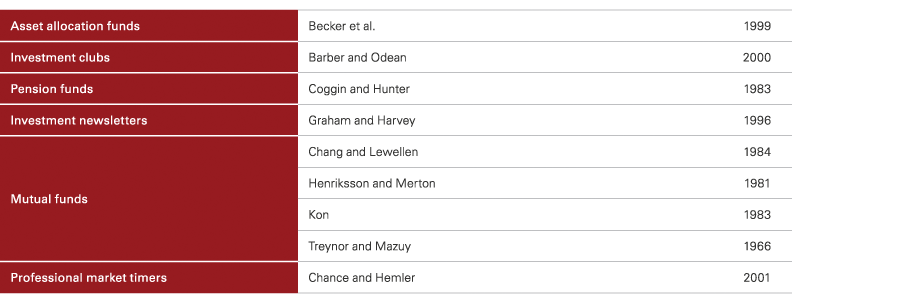Vanguard s principles for investing success
Post on: 29 Март, 2015 No Comment

1. Goals
Create clear, appropriate investment goals
An appropriate investment goal should be measureable and attainable. Success should not depend on outsize investment returns or impractical saving or spending requirements.
Defining goals clearly and being realistic about ways to achieve them can help protect investors from common mistakes that derail their progress.
Here we show that:
- Recognizing constraints, especially those that involve risk-taking, is essential to developing an investment plan.
- A basic plan will include specific, attainable expectations about contribution rates and monitoring.
- Discouraging results often come from chasing overall market returns, an unsound strategy that can seduce investors who lack well-grounded plans for achieving their goals.
- Without a plan, investors can be tempted to build a portfolio based on transitory factors such as fund ratingssomething that can amount to a buy high, sell low strategy.
Defining the goal and constraints
A sound investment planor policy statement, for institutionsbegins by outlining the investor’s objective as well as any significant constraints. Defining these elements is essential because the plan needs to fit the investor; copying other strategies can prove unwise.
Because most objectives are long-term, the plan should be designed to endure through changing market environments, and should be flexible enough to adjust for unexpected events along the way.
If the investor has multiple goals (for example, paying for both retirement and a child’s college expenses), each needs to be accounted for. Once the plan is in place, the investor should evaluate it at regular intervals.
* There are many definitions of risk, including the traditional definitions (volatility, loss, and shortfall) and some nontraditional ones (liquidity, manager, and leverage). Investment professionals commonly define risk as the volatility inherent to a given asset or investment strategy. For more on the various risk metrics used in the financial industry, see An Evaluation of Risk Metrics by Frank J. Ambrosio (Vanguard, 2007).
This example is completely hypothetical. It does not represent any real investor and should not be taken as a guide. Depending on an actual investor’s circumstances, such a plan or investment policy statement could be expanded or consolidated. For example, many financial advisors or institutions may find value in outlining the investment strategy; i.e. specifying whether tactical asset allocation will be employed, whether actively or passively managed funds will be used, and the like. Source: Vanguard.
Most investment goals are straightforwardsaving for retirement, preserving assets, funding a pension plan, or meeting a university’s spending requirements, for example. Constraints, on the other hand, can be either simple or complex, depending on the investor and the situation. The primary constraint in meeting any objective is the investor’s tolerance for market risk. Importantly, risk and potential return are generally related, in that the desire for greater return will require taking on greater exposure to market risk.
In most cases, the investment time horizon is another key constraint; for example, a university endowment with a theoretically infinite horizon might take some risks that would be unwise for an investor looking to fund a child’s college education. Other constraints can include exposure to taxes, liquidity requirements, legal issues, or unique factors such as a desire to avoid certain investments entirely. Because constraints may change over time, they should be closely monitored.
The danger of lacking a plan
Without a plan, investors often build their portfolios bottom-up, focusing on investments piecemeal rather than on how the portfolio as a whole is serving the objective. Another way to characterize this process is fund collecting: These investors are drawn to evaluate a particular fund and if it seems attractive, they buy it, often without thinking about how or where it may fit within the overall allocation.
The following charts demonstrate a risk of such behavior. They show how investors have tended to flock to funds with high performance ratings, and also how those highly rated funds have tended to underperform immediately after receiving the high marks.

Notes: Morningstar ratings are designed to bring returns, risks, and adjustments for sales loads together into one evaluation. To determine a fund’s star rating for a given time period (three, five, or ten years), the fund’s risk-adjusted return is plotted on a bell curve. If the fund scores in the top 10% of its category, it receives five stars; in the next 22.5%, four stars; in the middle 35%, three stars; in the next 22.5%, two stars; and in the bottom 10%, one star. The overall rating is a weighted average of the available three-, five-, and ten-year ratings.
To calculate the median performance versus style benchmarks, Vanguard first assigned each fund to a representative benchmark according to both size and style (growth versus value). We then compared the performance of each fund to the performance of its style benchmark for each 36-month period since June 1992. Funds were grouped according to their star ratings, and we then computed the median relative return versus the style benchmark for the subsequent 36-month period. Data are through December 2013.
Sources: Data on cash flows, fund returns, and ratings were provided by Morningstar. Index data to compute relative excess returns were provided by Thomson Reuters Datastream. More information is available in the 2010 Vanguard research paper Mutual Fund Ratings and Future Performance .
While paying close attention to each investment may seem logical, this process can lead to an assemblage of holdings that doesn’t serve the investor’s ultimate needs. As a result, the portfolio may wind up concentrated in a certain market sector, or it may have so many holdings that portfolio oversight becomes onerous. Most often, investors are led into such imbalances by common, avoidable mistakes such as performance-chasing, market-timing, or reacting to market noise.
Many investorsboth individuals and institutionsare moved to action by the performance of the broad stock market, increasing stock exposure during bull markets and reducing it during bear markets. Such buy high, sell low behavior is evident in mutual fund cash flows that mirror what appears to be an emotional responsefear or greedrather than a rational one. The chart below shows that not only do investors in aggregate allow their portfolios to drift with the markets, but they also tend to move cash between stock and bond investments in patterns that coincide with recent performance of the equity market. Over the four periods we identified, these cash flows, together with a failure to rebalance, amounted to buying high and selling low.
* Reflects cash flows starting in November 2007, when the bear market began, rather than for the full 24 months.
Notes: Equity allocations reflect the cumulative assets under management for all U.S.-domiciled open-ended mutual funds and ETFs. Cash flows represent net cash moving in or out of stock and bond funds. Market returns are based on the MSCI USA Index through May 1994 and the MSCI USA Investable Market Index thereafter. Sources: Morningstar for equity allocations and cash-flow data; Thomson Reuters Datastream for market returns.
For example, from 1993 to the market peak in March 2000, investors’ allocation to stock funds nearly doubled, and in the two years preceding that peak, as the market climbed 41%, investors poured nearly $400 billion into stock funds. Unfortunately, the stock market then reversed rather dramatically and returned 23% over the next two years.
A sound investment plan can help the investor to avoid such behavior, because it demonstrates the purpose and value of asset allocation, diversification, and rebalancing. It also helps the investor to stay focused on intended contribution and spending rates.
We believe investors should employ their time and effort up front, on the plan, rather than in ongoing evaluation of each new idea that hits the headlines. This simple step can pay off tremendously in helping them stay on the path toward their financial goals.
The key take-away
The best way to work toward an investment goal is to start by defining it clearly, take a level-headed look at the means of getting there, and then create a detailed, specific plan. Being realistic is essential to this process: Investors need to recognize their constraints and understand the level of risk they are able to accept.
They also need to be clear-eyed about the markets, because research has shown that pinning one’s hopes on outsize market returnsor on finding some investment that will outperform the marketsis not the most likely road to success.
- All investing is subject to risk, including possible loss of principal.
- Past performance does not guarantee future results.
- There is no guarantee that any particular asset allocation or mix of funds will meet your investment objectives or provide you with a given level of income.
- Diversification does not ensure a profit or protect against a loss.
- Bond funds are subject to the risk that an issuer will fail to make payments on time, and that bond prices will decline because of rising interest rates or negative perceptions of an issuer’s ability to make payments.
- The performance of an index is not an exact representation of any particular investment, as you cannot invest directly in an index.
- Data source for the interactive compounding illustration above: Vanguard.














